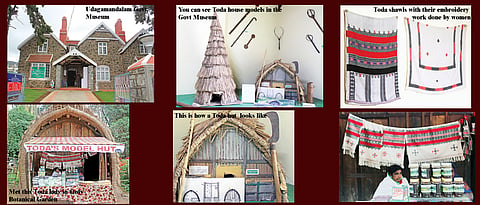

TODAS AND THE BUFFALOES
Todas are indigenous, the most primitive pastoral people, and reclusive in nature. It is said that the British took notice of them and fell in love with their culture and character. This tribal group was not easily accessible but you could see their settlements around the grasslands, where their buffaloes come for grazing.
Along with living in harmony with nature, the Todas have thrived on a special connection with buffalo herds. In fact, their culture revolved around the care and cult of a buffalo so much that they were not open to any kind of change or influence for decades. They believe that god created buffalo first and then came the humankind.
POOTHKULI
Todas can be easily identified with their dressing style. A piece of cloth is used as a mantle by both men and women. These shawls are adorned with the Toda embroidery, called Poothkuli. The style of work is called Pugur in the Toda language (meaning flower). Poothukuli holds a very important role in their festivals and funerals. This art has been passed on from one generation to another.
The Toda women have had a special expertise in a distinct style of weaving. The colours of the threads used by them are extremely endearing. A white fabric is beautifully enriched with rich red and black motifs. To create that richness and embossed effect, the embroidery is worked on the reverse of the cloth. Both the sides boast of an extremely neat work. They just have nine embroidery patterns, some of which include the sun, moon, squirrels, rabbits and buffalo horns.
I had heard myriad tales about Nilgiri Mountains (Blue Hills) and the ecosystem there. Then followed the quest around the famous Neelakurinji (bluish-violet flowers) which bloom once in 12 years, (2018 is the year of the purple flowers). Therefore, as soon as I had an opportunity to visit Wellington, a beautiful town in the Nilgiri district in Tamil Nadu, I had no second thoughts about my itinerary.
I knew and it did turn out to be a memorable trip — road tripping along rolling tea-estates of Kothagiri, visiting the oldest school of Lovedale, spending a night in an outhouse overlooking the Pykara lake, driving uphill for the views of the highest peak — Doddabetta, and taking a thrilling ride on the Niligiri Mountain Train. As for the cultural aspect, what really stood out was getting acquainted with the various tribes of the Nilgiris — Todas, Kotas, Kurumbas, Irulas, Mullukurumbas and Paniyans.
Here, I will talk about the Todas. A small stall put up by the Toda group at the Ooty botanical garden was my first acquaintance with them. Later, a beautiful red and black embroidery work by a tribal made me inquisitive about their art and culture and led me into reading more about their origins, customs and the changing lifestyle. Only when I visited the Stone House (Museum) in Ooty did I get a better perspective of their community, settlements and overall lifestyle.
MUND
As I headed away from the city towards the greens, I was amused by the sight of a few semicircular huts, which I was told later, was a Toda hamlet or mund. Ooty was called Ootacamund because it was a small Toda hamlet once.
The architecture is very interesting. Bamboo planks are latched together at regular intervals and the huts are patched with mud and straw. They have a small doorway, no windows and the walls are decorated with motifs of buffaloes. In some structures, one literally has to crawl to enter it.
Every mund has a temple, a parabolic structure and a head priest. Along with treating their buffalo as sacred, the Toda men worship a stone and use an earthen lamp in the temple. They don’t worship idols. Salutation for the sun is a morning ritual and they wind up their day with praises for nature. These tribes have an extensive knowledge of flowers.
MODERNISATION
There was a time when the Todas shifted their attention from buffaloes to agriculture but it did not really help them. The change in the ecosystem over the years has affected the tribal group. With the shrinking of the grasslands, there has been a massive decrease in the number of buffaloes, which directly impacts their existence, lives and culture.
I had a conversation with a tribal woman who said that with the changing needs of survival and several influences, continuing to live in their traditional ways was indeed difficult. It was a big blow for their culture to see the traditional ways of a whole community being lost to environmental degradation, development and modernisation. Of course there is no doubt that education has helped some of them carve a better life for themselves.
For me as an outsider, it was heartening to see that Tamil Nadu state government was promoting Toda culture at various tourist locations. The Toda lands are part of The Nilgiri Biosphere Reserve, a UNESCO-designated International Biosphere Reserve and their territory has been declared as Unesco World Heritage Site.
(The writer is a traveller who blogs about her experiences at www.manjulikapramod.com)
